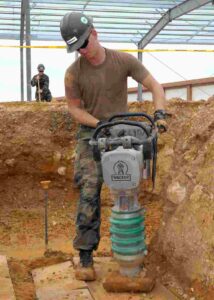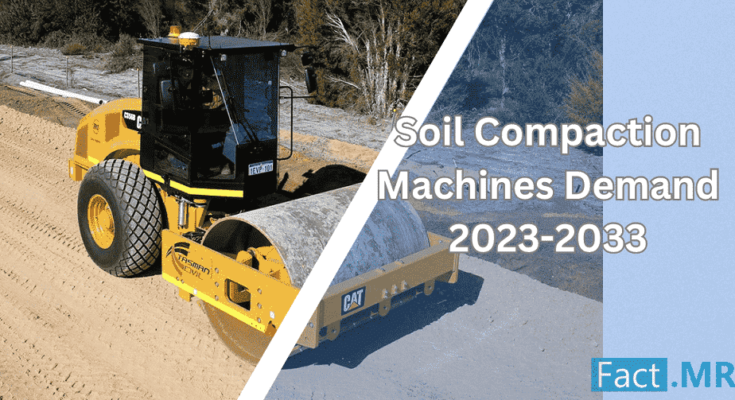Soil compaction plays a crucial role in both construction and agriculture by helping achieve optimal soil density. In construction, properly compacted soil provides a stable foundation for buildings, roads, and other structures, ensuring long-term structural integrity and preventing settlement or subsidence issues. In agriculture, compacted soil promotes better water drainage, increases load-bearing capacity for heavy machinery, and improves plant root development. Soil compaction machines are essential tools in achieving the desired soil density, ensuring stability, preventing erosion, and maximizing productivity in both industries.
Future Scope of Soil Compaction Machines
The future scope of soil compaction machines is promising and holds potential for further advancements. As technology continues to evolve, we can expect to see more efficient and intelligent machines that optimize the compaction process.
One aspect of the future scope lies in the development of more environmentally friendly soil compaction machines. There is a growing focus on sustainability and reducing carbon footprint in construction and agriculture. Therefore, we can anticipate the emergence of machines that use alternative energy sources, such as electric or hybrid-powered compactors, minimizing emissions and noise pollution.
Fact.MR anticipates the soil compaction machine sales to grow to US$ 10.6 billion by 2033.
According to the Fact.MR analysis, sales of soil compaction machines in the Asia Pacific region account for around 25% of the global market revenue share in 2023.
Get the complete analysis of the Soil Compaction Machines Industry
Furthermore, Smart compaction machines equipped with sensors and data analytics can provide real-time feedback on compaction levels and soil conditions. This will enable operators to make informed decisions and adjust compaction parameters accordingly, resulting in more precise and efficient compaction.
Businesses Studied in the Report
The key global businesses studied in the report analysis include the following companies:
- Caterpillar Inc. (NYSE: CAT)
- Volvo Construction Equipment (OTCMKTS: VLVLY)
- J.C. Bamford Excavators Limited
- John Deere
- Zoomlion Heavy Industries Science & Technology Co. Ltd.
- XCMG Co. Ltd.
- Sany Heavy Industries Co. Ltd.
- Fayat Group
- Hitachi Construction Machinery
- Wacker Neuson SE
Types of Soil Compaction Machines
Soil compaction machines are available in various types, each designed to suit different soil conditions and project requirements. Here are three commonly used types:
A. Vibratory Rollers: Vibratory rollers are widely used in construction and agriculture for soil compaction. They use vibration and weight to compact soil efficiently. Different types of vibratory rollers include smooth drum rollers, padfoot rollers, and pneumatic rollers. The choice of roller depends on factors such as soil type, moisture content, and desired compaction density.
B. Plate Compactors: Plate compactors are compact and versatile machines commonly used for smaller-scale projects or areas with limited space. They are ideal for compacting granular soils, asphalt, and paving stones. Plate compactors provide high-frequency vibration to achieve effective compaction.
C. Tamping Rammers: Tamping rammers, also known as jumping jacks or vibratory plate compactors, are handheld machines used for compacting smaller areas or tight spaces. They are particularly useful for compacting cohesive soils or backfilling trenches.

Tamping rammers use a percussive mechanism to compact the soil.
Each type of soil compaction machine has its advantages and limitations. The selection of the appropriate machine depends on factors such as the type of soil, project size, accessibility, and desired compaction density.
By choosing the right machine, construction, and agriculture professionals can achieve optimal soil density and ensure the success of their projects.
Factors to Consider When Choosing Soil Compaction Machines
Several factors should be considered when selecting soil compaction machines for a project. These factors include:
A. Soil Type and Moisture Content: Different soil types require different compaction methods and machines. Clay soils, for example, may require more forceful compaction compared to sandy soils. Additionally, the moisture content of the soil plays a crucial role in compaction. Some machines work better with dry soils, while others are more effective with moist soils.
B. Project Size and Accessibility: The size of the project area and its accessibility influence the choice of soil compaction machines. For larger projects, such as highways or large construction sites, larger and more powerful machines like vibratory rollers may be needed. In contrast, smaller-scale projects or areas with limited space may require compact and maneuverable machines like plate compactors.
C. Desired Compaction Density: The desired compaction density varies depending on the project requirements. Some projects may require a higher compaction density, while others may need a lower density. It is important to select a machine that can achieve the desired compaction level efficiently and effectively.
By considering these factors, construction and agriculture professionals can choose the most suitable soil compaction machine for their specific project needs, ensuring optimal soil compaction and successful outcomes.
Benefits of Using Soil Compaction Machines
1. Increases soil stability and load-bearing capacity.
2. Reduces soil settlement and potential for future damage.
3. Improves soil density and compaction uniformity.
4. Enhances the effectiveness of foundations and structures.
5. Prevents soil erosion and minimizes water infiltration.
6. Increases soil resistance to deformation and settlement.
7. Saves time and labor compared to manual compaction methods.
8. Improves overall project efficiency and productivity.
9. Provides consistent and reliable compaction results.
10. Reduces the need for future maintenance and repairs.
Conclusion
Soil compaction machines play a crucial role in increasing soil stability and load-bearing capacity, reducing settlement, and improving soil density and compaction uniformity. This leads to enhanced effectiveness of foundations and structures, minimizing the potential for future damage or failure.
Additionally, soil compaction machines help prevent soil erosion and minimize water infiltration, ensuring the long-term integrity of the project. They also save time and labor compared to manual compaction methods, improving overall project efficiency and productivity.
Read More
- Global Thermal Spray Coatings Market to Reach US$ 15 Billion by 2032
- Increasing Demand for Clean Energy to Drive Sales of Geothermal Heat Pumps



